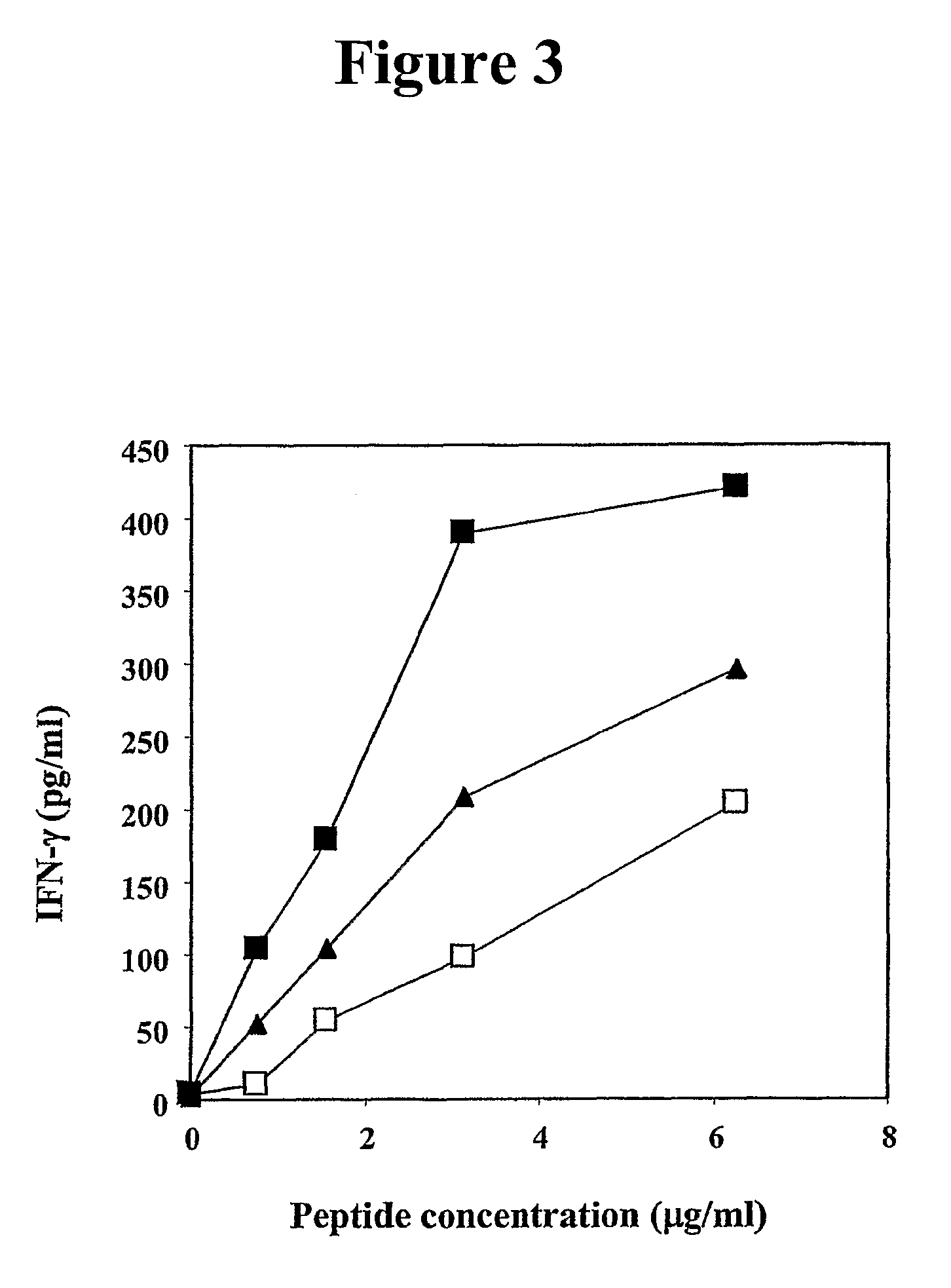Human cytotoxic T-lymphoctye epitope and its agonist eptiope from the non-variable number of tandem repeat sequence of MUC-1
a cytotoxic tlymphoctye epitope and human cytotoxic technology, applied in the field of tcell activation, can solve the problems of poor prognosis and high metastatic potential, limited information with respect to muc-1 expression and secretion, and low cytotoxic activity
- Summary
- Abstract
- Description
- Claims
- Application Information
AI Technical Summary
Benefits of technology
Problems solved by technology
Method used
Image
Examples
example 1
Materials and Methods
[0281]Cell Cultures.
[0282]The human breast adenocarcinoma cell line MCF-7 (HLA-A2 positive and MUC-1 positive), and SK-Mel-24 (HLA-A2 positive, MUC-1 negative) were purchased from American Type Culture Collection (Manassas, Va.). The cultures were free of mycoplasma and were maintained in complete medium [RPMI 1640 (Invitrogen Life Technologies, Carlsbad, Calif.) supplemented with 10% fetal bovine serum, 2 mM glutamine, 100 units / ml penicillin, and 100 μg / ml streptomycin (Invitrogen Life Technologies, Inc.)]. The C1R cell line is a human plasma leukemia cell line that does not express endogenous HLA-A or B antigens. C1R-A2 cells are C1R cells that express a transfected genomic clone of HLA-A2.1. These cells were obtained from Dr. William E. Biddison (National Institute of Neurological Disorders and Stroke, NIH, Bethesda, Md.). The 174CEM-T2 cell line (T2) transport deletion mutant was provided by Dr. Peter Cresswell (Yale University School of Medicine, New Haven...
example 2
Novel MUC-1 Binding Motifs
[0313]The primary amino acid sequence of human MUC-1 was analyzed for consensus motifs for novel HLA-A2 binding peptides. Twelve 10-mer peptides were identified, consequently synthesized, and studied for binding to the HLA-A2 molecule in a T2 cell binding assay. The amino acid sequences and positions of these 10-mer peptides are shown in Table 1. The CEA CAP1-6D peptide and a NCA peptide were used as a positive and negative control, respectively. The predicted binding of the 12 peptides are also given in Table 1. Three of these peptides (P-92, P-94 and P-1108) were shown to have the highest level of binding in the T2 assay.
[0314]
TABLE 1Binding of human MUC-1 peptides to HLA-A2moleculesAmino acidPredictedSEQPosition inbinding toT2IDPeptideMUC-1SequenceHLA-A2*binding#NO:P-9292-101ATWGQDVTSVPOS7401P-9494-103WGQDVTSVPVNEG5918P-11081108-1117REGTINVHDVNEG4829P-44-13GTQSPFFLLLNEG46710P-11051105-1114LAFREGTINVNEG46111P-11041004-1013TLASHSTKTDNEG44212P-10691069-1078...
example 3
Establishment of MUC-1 Specific T Cell Lines
[0315]Studies were then conducted to determine if MUC-1-specific T-cell lines could be established from PBMCs of an apparently healthy donor. To accomplish this, autologous DCs infected with rF-MUC-1 / TRICOM were used as APC. rF-MUC-1 / TRICOM is a replication-defective avipox vector containing the transgenes for MUC-1 and for a triad of human costimulatory molecules (B7-1, ICAM-1 and LFA-3, designated TRICOM). rF-MUC-1 / TRICOM was shown to efficiently infect human DCs and hyperexpress each of the costimulatory molecules, as well as MUC-1, on the DC surface (Table 2). Approximately 96% of the cells were CD11c and MHC-class II positive.
[0316]
TABLE 2Phenotypic analysis of DCs infected with rF-MUC-1 / TRICOMDendritic cellsinfected withCD80CD54CD58Class IMUC-1Uninfected4.8 (13.6)59.5 (62.3)68.1 (18.2)99.7 (271.8)5.0 (95.7)FP / WT7.4 (13.3)79.3 (83.4)74.0 (19.5)99.5 (176.3)3.1 (50.7)rF-MUC-30.9 (35.7) 84.5 (133.9)79.8 (27.4)99.9 (189.3)31.6 (213.1)1 / T...
PUM
| Property | Measurement | Unit |
|---|---|---|
| concentrations | aaaaa | aaaaa |
| concentrations | aaaaa | aaaaa |
| concentration | aaaaa | aaaaa |
Abstract
Description
Claims
Application Information
 Login to View More
Login to View More - R&D
- Intellectual Property
- Life Sciences
- Materials
- Tech Scout
- Unparalleled Data Quality
- Higher Quality Content
- 60% Fewer Hallucinations
Browse by: Latest US Patents, China's latest patents, Technical Efficacy Thesaurus, Application Domain, Technology Topic, Popular Technical Reports.
© 2025 PatSnap. All rights reserved.Legal|Privacy policy|Modern Slavery Act Transparency Statement|Sitemap|About US| Contact US: help@patsnap.com



